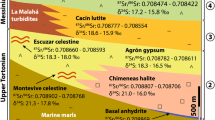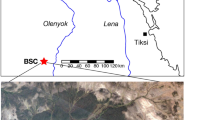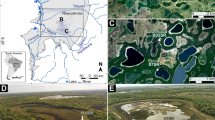Abstract
Continental rift systems are often characterized by geothermal activity and associated discharge of hot groundwater, which can substantially impact the water, solute and sediment budgets of rift-valley lakes. Hot-spring inflow can result in complex lake hydro- and geochemistry, but also buffers against the desiccation of closed-basin lakes in dry climate regimes. Consequently, hydrothermally fed lakes can potentially provide continuous sedimentary records from regions where other types of paleoenvironmental archives are lacking. This is illustrated by Nasikie Engida, a shallow hypersaline and alkaline (soda) lake in the semiarid Rift Valley of southern Kenya. Here, inflow of hot-spring water has maintained a shallow but permanent water body and continuous deposition of sediments through past climate episodes when many other lakes in the eastern (Gregory) branch of the East African Rift System stood dry. We present the first data on late-Holocene sedimentation in this remarkable lacustrine system, typified by authigenic nahcolite [NaH(CO3)] formation during part of its recorded history. Our data include measurements of bulk-sediment and mineralogical composition, clastic-mineral grain size and magnetic susceptibility. Analytical issues related to the large amount of salts within the sediments, both as crystals and in solution in the pore water, are discussed. We also present exploratory time series of the stable-isotope composition of bulk organic matter and authigenic nahcolite. Core lithostratigraphy and preliminary radiocarbon dating indicate that Nasikie Engida has accumulated finely laminated sediments continuously since ca. 2850 cal year BP, which is remarkable given its current maximum depth of only 1.6 m. Synsedimentary nahcolite appears abruptly ~ 2260 cal year BP and since then has been deposited regularly, in the form of distinct pure layers up to several cm thick. Its formation has been enabled by high pCO2, supplied principally from geothermal sources, accumulating in a high-density brine. Although Nasikie Engida has likely been saline over the entire time span covered by the studied sediment sequence, variation in nahcolite deposition and bulk-sediment composition suggests multi-decadal to centennial oscillations in water-column stability and stream inflow driven by variation in climatic moisture balance. Further analyses of this paleoenvironmental archive may thus produce the first continuous climate-proxy record from a vast dry region of equatorial East Africa. Moreover, Nasikie Engida’s extraordinary setting makes it a unique modern analogue for the interpretation of ancient nahcolite-bearing salt-lake deposits.






Similar content being viewed by others
References
Baker BH, Mitchell JG (1976) Volcanic stratigraphy and geochronology of the Kedong–Olorgesailie area and the evolution of the south Kenya rift valley. J Geol Soc 132:467–484
Becht R, Mwango F, Muno FA (2006) Groundwater links between Kenyan Rift Valley lakes. In: Odada E, Olago DO (eds) Proceedings of the 11th World Lakes Conference, Nairobi, Kenya, vol 2, pp 7–14
Bengtson L, Enell M (1986) Chemical analysis. In: Berglund BE (ed) Handbook of holocene palaeoecology and palaeohydrology. Wiley, New York, pp 485–496
Bessems I, Verschuren D, Russell JM, Hus J, Mees F, Cumming BF (2008) Paleolimnological evidence for widespread late 18th century drought across equatorial East Africa. Palaeogeogr Palaeoclimatol Palaeoecol 259:107–120
Björk S, Wohlfarth B (2001) 14C chronostratigraphic techniques in paleolimnology. In: Last WM, Smol JP (eds) Tracking environmental change using lake sediments. Basin analysis, coring, and chronological techniques, vol I. Kluwer Academic Publishers, Dordrecht, pp 205–245
Blaauw M, Christen JA (2011) Flexible paleoclimate age-depth models using an autoregressive gamma process. Bayesian Anal 6:457–474
Bowen GJ (2017) The online isotopes in precipitation calculator, version 3.1. http://www.waterisotopes.org. Accessed June 2018
Bowen GJ, Revenaugh J (2003) Interpolating the isotopic composition of modern meteoric precipitation. Water Resour Res 39:1299. https://doi.org/10.1029/2003WR002086
Cappa CD, Hendricks MB, DePaolo DJ, Cohen RC (2003) Isotopic fractionation of water during evaporation. J Geophys Res 108:1–10. https://doi.org/10.1029/2003JD003597
Cohen A, Campisano C, Arrowsmith R et al (2016) The Hominin Sites and Paleolakes Drilling Project: inferring the environmental context of human evolution from eastern African rift lake deposits. Sci Drill 21:1–16. https://doi.org/10.5194/sd-21-1-2016
Cruciani G (2006) Zeolites upon heating: factors governing their thermal stability and structural changes. J Phys Chem Solids 67:1973–1994
Damnati B, Taieb M (1995) Solar and ENSO signatures in laminated deposits from lake Magadi (Kenya) during the Pleistocene/Holocene transition. J Afr Earth Sci 21:373–382. https://doi.org/10.1016/0899-5362(95)00094-A
De Cort G, Bessems I, Keppens E, Mees F, Cumming B, Verschuren D (2013) Late-Holocene and recent hydroclimatic variability in the central Kenya Rift Valley: the sediment record of hypersaline lakes Bogoria, Nakuru and Elementeita. Palaeogeogr Palaeoclimatol Palaeoecol 388:69–80. https://doi.org/10.1016/j.palaeo.2013.07.029
De Cort G, Verschuren D, Ryken E, Wolff C, Renaut RW, Creutz M, Van der Meeren T, Haug G, Olago DO, Mees F (2018) Multi-basin depositional framework for moisture-balance reconstruction during the last 1300 years at Lake Bogoria, central Kenya Rift Valley. Sedimentology 65:1667–1696. https://doi.org/10.1111/sed.12442
Dean WE (1974) Determination of carbonate and organic-matter in calcareous sediments and sedimentary-rocks by loss on ignition—comparison with other methods. J Sed Petrol 44:242–248
Dyni JR (1996) Sodium carbonate resources of the Green River Formation in Utah, Colorado, and Wyoming. US Geological Survey Open-File Report, 96-729, 42 pp
Ebinger CJ, Yemane T, Hardling DJ, Tesfaye S, Kelley S, Rex DC (2000) Rift deflection, migration, and propagation: linkage of the Ethiopian and Eastern rifts, Africa. Geol Soc Am Bull 112:163–176
Eugster HP (1966) Sodium carbonate–bicarbonate minerals as indicators of PCO2. J Geophys Res 71:3369–3377
Eugster HP (1970) Chemistry and origin of the brines of Lake Magadi, Kenya. Miner Soc Am Spec Pap 3:213–235
Eugster HP (1971) Origin and deposition of trona. Univ Wyoming Contrib Geol 10:49–55
Eugster HP (1980) Lake Magadi, Kenya, and its precursors. Dev Sedimentol 28:195–232. https://doi.org/10.1016/S0070-4571(08)70239-5
Eugster HP (1986) Lake Magadi, Kenya: a model for rift valley hydrochemistry and sedimentation? Geol Soc Lond Spec Publ 25:177–189
Eugster HP, Hardie LA (1978) Saline lakes. In: Lerman A (ed) Lakes: chemistry, geology, physics. Springer, New York, pp 237–293
Eugster HP, Jones BF (1979) Behavior of major solutes during closed-basin brine evolution. Am J Sci 279:609–631
Gasse F (2000) Hydrological changes in the African tropics since the Last Glacial Maximum. Quat Sci Rev 19:189–211. https://doi.org/10.1016/S0277-3791(99)00061-X
Grant WD (2006) Alkaline environments and biodiversity. In: Gerday S, Glansdorff N (eds) Encyclopedia of life support systems. Eolss Publishers, Oxford
Hammer UT (1986) Saline lake ecosystems of the world. Junk Publishers, Dordrecht
Hardie LA, Lowenstein TK, Spencer RJ (1985) The problem of distinguishing between primary and secondary features in evaporates. In: Schreiber BC, Harner HL (eds) Sixth international symposium on salt, vol 1. Salt Institute, Alexandria, pp 11–39
Heiri O, Lotter AF, Lemcke G (2001) Loss on ignition as a method for estimating organic and carbonate content in sediments: reproducibility and comparability of results. J Paleolimnol 25:101–110
Hillaire-Marcel C, Carro O, Casanova J (1986) 14C and Th/U dating of Pleistocene and Holocene stromatolites from East African paleolakes. Quat Res 25:312–329. https://doi.org/10.1016/0033-5894(86)90004-9
Horita J (2009) Isotopic evolution of saline lakes in the low-latitude and polar regions. Aquat Geochem 15:43–69
Horton TW, Defliese WF, Tripati AK, Oze C (2016) Evaporation induced 18O and 13C enrichment in lake systems: a global perspective on hydrologic balance effects. Quat Sci Rev 131:365–379. https://doi.org/10.1016/j.quascirev.2015.06.030
Hughes L (2008) Mining the Maasai Reserve: the story of Magadi. J East Afr Stud 2:134–164. https://doi.org/10.1080/17531050701847326
Ibs-von Seht M, Blumenstein S, Wagner R, Hollnack D, Wohlenberg J (2001) Seismicity, seismotectonics and crustal structure of the southern Kenya Rift-new data from the Lake Magadi area. Geophys J Int 146:439–453
International Atomic Energy Agency and World Meteorological Organization IAEA/WMO (2015) Global network of isotopes in precipitation. The GNIP database. https://nucleus.iaea.org/wiser. Accessed June 2018
Isaac GL (1977) Olorgesailie: archeological studies of a middle Pleistocene Lake Basin in Kenya. University of Chicago Press, Chicago
Ito E (2001) Application of stable isotope techniques to inorganic and biogenic carbonates. In: Last WM, Smol JP (eds) Tracking environmental change using lake sediments. Physical and geochemical methods, vol 2. Kluwer Academic Publishers, Dordrecht, pp 351–371
Jagniecki EA, Lowenstein TK, Jenkins DM, Demicco RV (2015) Eocene atmospheric CO2 from the nahcolite proxy. Geology 43(G36886):1. https://doi.org/10.1130/G36886.1
Kalff J (2001) Limnology. Prentice Hall, Upper Saddle River
Keener TC, Frazier GC, Davis WT (1985) Thermal decomposition of sodium bicarbonate. Chem Eng Commun 33:93–105. https://doi.org/10.1080/00986448508911162
Lee H, Muirhead JD, Fischer TP et al (2016) Massive and prolonged deep carbon emissions associated with continental rifting. Nat Geosci 9:145–149. https://doi.org/10.1038/ngeo2622
Lee H, Fischer TP, Muirhead JD, Ebinger CJ, Kattenhorn SA, Sharp ZD, Kianji G, Takahata N, Sano Y (2017) Incipient rifting accompanied by the release of subcontinental lithospheric mantle volatiles in the Magadi and Natron basin, East Africa. J Volcanol Geotherm Res 346:118–133
Leng MJ, Lamb AL, Heaton THE, Marshall JD, Wolfe B, Jones M, Holmes J, Arrowsmith C (2006) Isotopes in lake sediments. In: Leng M (ed) Isotopes in palaeonvironmental research. Developments in palaeonvironmental research, vol 10. Springer, Dordrecht, pp 147–184
Levin NE, Zipser EJ, Cerling TE (2009) Isotopic composition of waters from Ethiopia and Kenya: insights into moisture sources for eastern Africa. J Geophys Res. https://doi.org/10.1029/2009JD012166
Lewis ML (1987) Tropical limnology. Ann Rev Ecol Syst 18:159–184
Lewis ML (1996) Tropical lakes: how latitude makes a difference. In: Schiemer F, Boland KT (eds) Perspectives in tropical limnology. SPB Academic Publishing bv, Amsterdam
Lowenstein TK, Demicco RV (2006) Elevated Eocene atmospheric CO2 and its subsequent decline. Science 313:1928. https://doi.org/10.1126/science.1129555
Lowenstein TK, Jagniecki EA, Carroll AR et al (2017) The Green River salt mystery: what was the source of the hyperalkaline lake waters? Earth-Sci Rev 173:295–306. https://doi.org/10.1016/j.earscirev.2017.07.014
McNulty E (2017) Lake Magadi and the soda lake cycle: a study of the modern sodium carbonates and of late Pleistocene and Holocene lacustrine core sediments. Unpublished M.Sc. thesis, Binghamton University, USA
Mees F, Reyes E, Keppens E (1998) Stable isotope chemistry of gaylussite and nahcolite from the deposits of the crater lake at Malha, northern Sudan. Chem Geol 146:87–98. https://doi.org/10.1016/S0009-2541(98)00006-0
Melack JM (1981) Photosynthetic activity of phytoplankton in tropical African soda lakes. Hydrobiologia 81:71–85
Melack JM (1988) Primary producer dynamics associated with evaporative concentration in a shallow, equatorial soda lake (Lake Elmenteita, Kenya). Hydrobiologia 158:1–14
Melack JM, MacIntyre S (2016) Morphometry and physical processes of East African soda lakes. In: Schagerl M (ed) Soda lakes of East Africa. Springer International Publishing, Cham. https://doi.org/10.1007/978-3-319-28622-8
Mengistou S (2016) Invertebrates of East African soda lakes. In: Schagerl M (ed) Soda lakes of East Africa. Springer, Cham. https://doi.org/10.1007/978-3-319-28622-8
Meyers PA (1994) Preservation of elemental and isotopic source identification of sedimentary organic matter. Chem Geol 114:289–302
Meyers PA, Lallier-Vergès E (1999) Lacustrine sedimentary organic matter records of Late Quaternary paleoclimates. J Paleolimnol 21:345–372
Meyers PA, Teranes JL (2001) Sediment organic matter. In: Last WM, Smol JP (eds) Tracking environmental change using lake sediments. Physical and geochemical methods, vol 2. Kluwer Academic Publishers, Dordrecht, pp 239–269
Monnin C, Schott J (1984) Determination of the solubility products of sodium carbonate minerals and an application to trona deposition in Lake Magadi (Kenya). Geochim Cosmochim Acta 48:571–581. https://doi.org/10.1016/0016-7037(84)90285-0
Mook WG, Bommerson JC, Staverman WH (1974) Carbon isotope fractionation between dissolved bicarbonate and gaseous carbon dioxide. Earth Planet Sci Lett 22:169–176. https://doi.org/10.1016/0012-821X(74)90078-8
NASA LP DAAC (2011) ASTER Global Digital Elevation Model, version 2. NASA EOSDIS Land Processes DAAC, USGS Earth Resources Observation and Science (EROS) Center, Sioux Falls, South Dakota. https://lpdaac.usgs.gov. Accessed 10 July 2017
Otto-Bliesner BL, Russell JM, Clark PU, Liu Z, Overpeck JT, Konecky B, deMenocal P, Nicholson SE, He F, Lu Z (2014) Coherent changes of southeastern equatorial and northern African rainfall during the last deglaciation. Science 346:1223–1227
Owen RB, Muiruri VM, Lowenstein TK, Renaut RW, Rabideaux N, Luo S, Deino AL, Sier MJ, Dupont-Nivet G, McNulty EP, Leet K, Cohen A, Campisano C, Deocampo D, Shen C, Billingsley A, Mbuthia A (2018) Progressive aridification in East Africa over the last half million years and implications for human evolution. Proc Natl Acad Sci USA 115:11174–11179
Owen RB, Renaut RW, Muiruri VM, Rabideaux NM, Lowenstein TK, McNulty EP, Leet K, Deocampo D, Luo S, Deino AL, Cohen A, Sier MJ, Campisano C, Shen C, Billingsley A, Mbuthia A, Stockhecke M (2019) Quaternary history of the Lake Magadi Basin, southern Kenya Rift: tectonic and climatic controls. Palaeogeogr Palaeoclimatol Palaeoecol 518(97):118
Potts R, Behrensmeyer AK, Faith JT, Tryon CA, Brooks AS, Yellen JE, Deino ML, Kinyanjui R, Clark JB, Haradon CM, Levin NE, Meijer HJM, Veatch EG, Owen RB, Renaut RW (2018) Environmental dynamics during the onset of the Middle Stone Age in eastern Africa. Science 360:86–90
Rasband WS (1997) ImageJ. U.S. National Institutes of Health, Bethesda, Maryland, USA. https://imagej.nih.gov/ij/. Accessed June 2018
Reimer PJ, Bard E, Bayliss A, Beck JW, Blackwell PG, Ramsey CB, Buck CE, Cheng H, Edwards RL, Friedrich M, Grootes PM, Guilderson TP, Haflidason H, Hajdas I, Hatte C, Heaton TJ, Hoffmann DL, Hogg AG, Hughen KA, Kaiser KF, Kromer B, Manning SW, Niu M, Reimer RW, Richards DA, Scott EM, Southon JR, Staff RA, Turney CSM, van der Plicht J (2013) INTCAL13 and MARINE13 radiocarbon age calibration curves 0–50,000 years cal bp. Radiocarbon 55:1869–1887
Roberts N, Taieb M, Barker P, Damnati B, Icole M, Williamson D (1993) Timing of the Younger Dryas event in East Africa from lake level changes. Nature 366:146–148. https://doi.org/10.1038/366146a0
Royer DL (2014) Atmospheric CO2 and O2 during the phanerozoic: tools, patterns, and impacts. In: Holland HD, Turekian KK (eds) Treatise on geochemistry, 2nd edn. Oxford University Press, New York, pp 251–267. https://doi.org/10.1016/b978-0-08-095975-7.01311-5
Rumes B, Eggermont H, Verschuren D (2005) Representation of aquatic invertebrate communities in subfossil death assemblages sampled along a salinity gradient of western Uganda crater lakes. Hydrobiologia 542:297–314
Rumes B, Eggermont H, Verschuren D (2011) Distribution and faunal richness of Cladocera in western Uganda crater lakes. Hydrobiologia 676:39–56
Ryner M, Holmgren K, Taylor D (2008) A record of vegetation dynamics and lake level changes from Lake Emakat, northern Tanzania, during the last c. 1200 years. J Paleolimnol 40:583–601
Sandgren P, Snowball I (2001) Application of mineral magnetic techniques to paleolimnology. In: Last WM, Smol JP (eds) Tracking environmental change using lake sediments. Physical and geochemical methods, vol 2. Kluwer Academic Publishers, Dordrecht, pp 217–238
Schagerl M, Renaut RW (2016) Dipping into the soda lakes of East Africa. In: Schagerl M (ed) soda lakes of East Africa. Springer, Cham, pp 3–24. https://doi.org/10.1007/978-3-319-28622-8
Surdam RC, Eugster HP (1976) Mineral reactions in the sedimentary deposits of the Lake Magadi region, Kenya. Geol Soc Am Bull 87:1739–1752
Talbot MR (1990) A review of the palaeohydrological interpretation of carbon and oxygen isotopic ratios in primary lacustrine carbonates. Chem Geol Isot Geosci Sect 80:261–279. https://doi.org/10.1016/0168-9622(90)90009-2
Talling JF, Lemoalle J (1998) Ecological dynamics of tropical inland waters. Cambridge University Press, Cambridge
Tiercelin J-J, Lezzar K-E (2002) A 300 million years history of rift lakes in Central and East Africa: and updated broad review. In: Odada EO, Olago DO (eds) The East African great lakes: limnology, palaeolimnology and biodiversity Advances in global change research, vol 12. Kluwer Academic Publishers, Dordrecht, pp 3–60
Trabucco A, Zomer R (2009) Global Aridity Index (Global-Aridity) and Global Potential Evapo-Transpiration (Global-PET) geospatial database. CGIAR Consortium for Spatial Information. http://www.csi.cgiar.org. Accessed June 2018
Trauth MH, Maslin MA, Deino A, Strecker MR (2005) Late Cenozoic moisture history of East Africa. Science 309:2051–2053
Trauth MH, Maslin MA, Deino AL, Strecker MR, Bergner AGN, Dühnforth M (2007) High- and low-latitude forcing of Plio-Pleistocene East African climate and human evolution. J Hum Evol 53:475–486
Vaasma T (2008) Grain-size analysis of lacustrine sediments: a comparison of pre-treatment methods. Est J Ecol 57:231–243. https://doi.org/10.3176/eco.2008.4.01
Verschuren D (1999a) Influence of depth and mixing regime on sedimentation in a small, fluctuating tropical soda lake. Limnol Oceanogr 44:1103–1113
Verschuren D (1999b) Sedimentation controls on the preservation and time resolution of climate-proxy records from shallow fluctuating lakes. Quat Sci Rev 18:821–837
Verschuren D, Cocquyt C, Tibby J, Roberts CN, Leavitt PR (1999) Long-term dynamics of algal and invertebrate communities in a small, fluctuating tropical soda lake. Limnol Oceanogr 44:1216–1231
Verschuren D, Tibby J, Sabbe K, Roberts N (2000) Effects of depth, salinity, and substrate on the invertebrate community of a fluctuating tropical lake. Ecology 81:164–182
Weinstein A, Oliva SJ, Ebinger CJ, Roecker S, Tiberi C, Aman M, Lambert C, Witkin E, Albaric J, Gautier S, Peyrat S, Muirhead JD, Muzuka ANN, Mulibo G, Kianji G, Ferdinand-Wambura R, Msabi M, Rodzianko A, Hadfield R, Illsley-Kemp F, Fischer TP (2017) Fault-magma interactions during early continental rifting: seismicity of the Magadi–Natron–Manyara basins, Africa. Geochem Geophys Geosyst 18:3662–3686
Wright HE (1967) A square-rod piston sampler for lake sediments. J Sediment Petrol 37:975–976
Wright HE (1980) Cores of soft lake sediments. Boreas 9:107–114. https://doi.org/10.1111/j.1502-3885.1980.tb01032.x
Acknowledgements
This work was conducted as part of the Belgian Science Policy (Belspo) Brain-be project ‘Patterns and Mechanisms of Climate Extremes in East Africa’, BR/121/A2/PAMEXEA, with additional support for fieldwork provided by the Research Foundation Flanders (FWO, grant no. K215514N). RWR acknowledges support from the Hominin Sites and Paleolakes Drilling Project (funded by NSF, ICDP and other agencies) and NSERC (Canada). The authors thank Yoeri Torsy (Limnology Unit, Ghent University), David Verstraeten (Analytical, Environmental and Geo-chemistry, Vrije Universiteit Brussel) and Veerle Vandenhende (MinPet Laboratory, Ghent University) for assistance in laboratory analyses.
Author information
Authors and Affiliations
Corresponding author
Additional information
Publisher's Note
Springer Nature remains neutral with regard to jurisdictional claims in published maps and institutional affiliations.
Electronic supplementary material
Below is the link to the electronic supplementary material.
Rights and permissions
About this article
Cite this article
De Cort, G., Mees, F., Renaut, R.W. et al. Late-Holocene sedimentation and sodium carbonate deposition in hypersaline, alkaline Nasikie Engida, southern Kenya Rift Valley. J Paleolimnol 62, 279–300 (2019). https://doi.org/10.1007/s10933-019-00092-2
Received:
Accepted:
Published:
Issue Date:
DOI: https://doi.org/10.1007/s10933-019-00092-2




